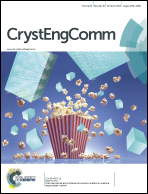Two isomeric [Cu4I4] luminophores: solvothermal/mechanochemical syntheses, structures and thermochromic luminescence properties†
Abstract
The solvothermal reaction of CuI with 1,4-bis(pyridin-4-ylmethyl)piperazine (bpmp) in different stoichiometric ratios gave rise to the isolation of two copper(I) iodide coordination polymers, namely [Cu4I4(bpmp)2]n (1) and [Cu4I4(bpmp)3]n (2). Complex 1 exhibits a 2D non-interpenetrated 44-sql net constructed from cubic [Cu4I4] cluster building units, whereas 2 is a 2D → 3D inclined interpenetrated 44-sql net incorporating stairstep [Cu4I4] clusters. Both 1 and 2 could also be obtained under liquid-assisted grinding conditions, as confirmed by comparative powder X-ray diffraction (PXRD). Interestingly, complex 1 has a bright yellow emission with a maximum at 585 nm that shifts bathochromically to 615 nm when cooling to 77 K, whereas the emission of 2 has a maximum at 502 nm and a less pronounced temperature dependence. Two isomeric [Cu4I4] luminophores controlled by the reactant ratio are responsible for their different emission behaviors. The Cu⋯Cu distances in 1 at different temperatures are measured to demonstrate the relationship between Cu⋯Cu interactions and the peculiar luminescence properties of 1.
![Graphical abstract: Two isomeric [Cu4I4] luminophores: solvothermal/mechanochemical syntheses, structures and thermochromic luminescence properties](/en/Image/Get?imageInfo.ImageType=GA&imageInfo.ImageIdentifier.ManuscriptID=C3CE42195C&imageInfo.ImageIdentifier.Year=2014)

 Please wait while we load your content...
Please wait while we load your content...